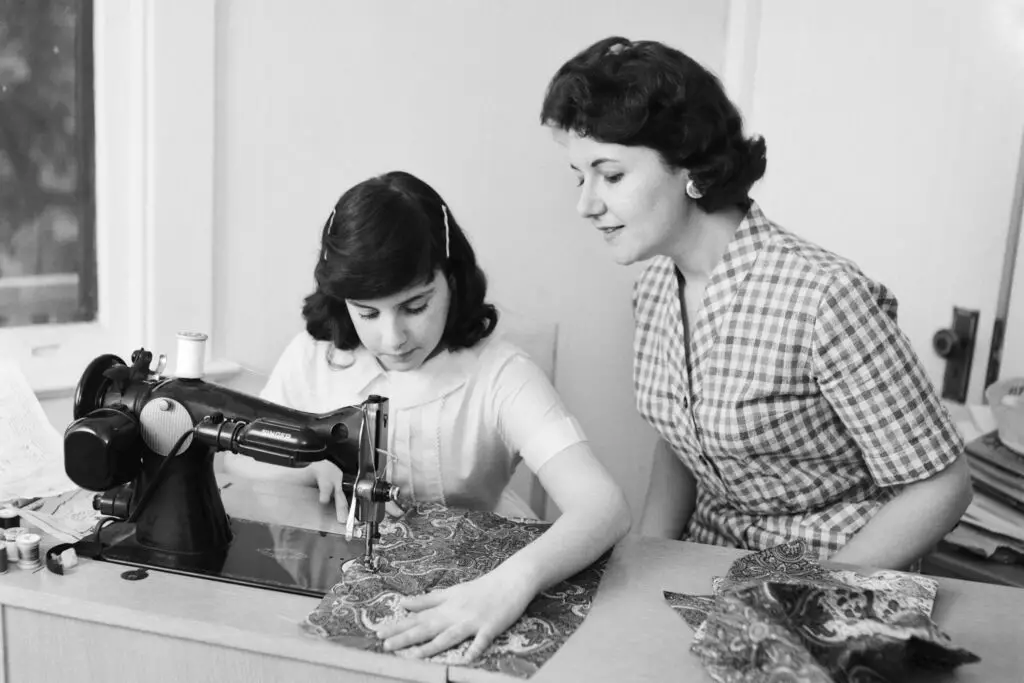1. Penmanship

There was a time when mastering cursive writing felt like a rite of passage. Entire classes were devoted to making perfect loops and consistent slants, with teachers walking around pointing out your pencil grip or posture. Kids would practice for hours, filling notebooks with sentences like “The quick brown fox jumps over the lazy dog.” Your handwriting was a reflection of who you were, and messy script might even cost you points on an assignment says PRINT Magazine.
Now, most schools have cut penmanship completely. Many kids don’t even learn cursive, let alone how to read it. With everything typed these days, there’s just no pressure to have neat handwriting. And honestly, when was the last time you had to write anything longer than a signature by hand? It’s one of those quiet casualties of the digital age. What used to be considered a crucial life skill is now a charming relic of the past adds BBC.
2. Home Economics

Once a staple for middle and high schoolers, home economics taught everything from sewing to cooking to balancing a budget. The idea was to prepare students for daily life—basic survival skills that everyone, regardless of gender, could benefit from. Many remember learning how to bake muffins or hem pants, often in classrooms filled with the scent of something delicious from the oven. It was practical and hands-on, a refreshing break from textbooks shares PBS.
Today, this class is almost extinct. While a few schools still offer it under a different name like “Family and Consumer Science,” it’s rarely required. That’s a shame, especially when so many young adults enter the world with no clue how to do laundry or manage their money. The shift toward STEM subjects pushed it out of the spotlight. But ask anyone who took it, and they’ll likely say it taught them things they still use today shares New York Post.
3. Typing

Typing class was once essential, and for good reason. Students would sit at rows of computers or even typewriters, tapping away to the rhythm of timed drills. WPM (words per minute) scores were a source of pride or shame, and proper finger placement was drilled into everyone. It felt tedious at times, but it laid the groundwork for everything from writing essays to future office jobs.
Now, kids just kind of learn to type along the way. They grow up with tablets and smartphones, tapping out texts before they can spell “keyboard.” While that gives them speed, it doesn’t always give them accuracy. You can spot a bad typer a mile away, especially if they’re still hunting and pecking in high school. Despite our digital world, formal typing instruction has quietly disappeared. And the funny part? We probably need it now more than ever.
4. Shop Class

There was a time when every school had a shop room, filled with the smell of sawdust and the buzz of drills. Students learned woodworking, metalwork, and even car repair, walking away with something tangible they built with their own hands. These classes weren’t just for kids planning to be mechanics, either—they taught practical skills like using tools safely and problem-solving on the fly. And honestly, they were a blast.
But shop class has nearly vanished from most schools. Liability issues, budget cuts, and a push toward college-prep courses edged it out. Now, unless you’re in a specialty program, you’re unlikely to get near a band saw in school. That’s a real loss, especially for kids who thrive working with their hands. Not everyone’s built for AP Chemistry, and shop gave students another way to shine. Plus, knowing how to fix things is never a bad life skill.
5. Latin

Latin used to be a cornerstone of a solid education. For centuries, it was taught in schools to help students with grammar, vocabulary, and understanding classical texts. Even into the ’50s and ’60s, it wasn’t unusual for high schoolers to be conjugating Latin verbs or translating Caesar’s writings. It felt a bit old-fashioned even then, but it was considered a sign of serious learning.
These days, Latin is mostly gone from mainstream schools. It’s occasionally offered as an elective, but rarely required. Some parents push for it to help with SAT scores or medical terminology, but it’s no longer seen as essential. Foreign language requirements now favor Spanish, French, or Mandarin. Latin’s slow fade has left behind a lot of “et cetera” and “carpe diem,” but not much else. Still, it gave a certain gravitas to a report card.
6. Driver’s Ed

Once upon a time, learning to drive was part of the high school experience. Schools offered driver’s education as a standard class, complete with simulators, classroom lessons, and behind-the-wheel practice. It made sense—why not teach teens a life-or-death skill in a structured setting? Plus, it saved families money by making licensing more affordable.
Today, driver’s ed is largely outsourced to private companies. Liability concerns and shrinking school budgets made it an easy cut. Now, many teens get minimal instruction and are rushed through the process. Not all families can afford private classes, either. As a result, we’ve got young drivers hitting the road with less training than ever. It’s hard not to miss the days when the school parking lot doubled as a driving course.
7. Debate

Debate club wasn’t just for future lawyers. It was a full class in many schools, helping students learn how to research, think critically, and argue respectfully. You had to build a case, anticipate counterarguments, and present your ideas clearly under pressure. It taught confidence, poise, and how to disagree without yelling—skills that feel especially rare now.
Sadly, debate programs have been whittled down or folded into general English classes. With so much focus on standardized testing, there’s not much room left for spontaneous thinking. That’s a loss, because debating teaches you to really listen and respond thoughtfully. It forces you to see multiple sides of an issue, even ones you don’t agree with. In an age of hot takes and internet shouting, those lessons feel more important than ever.
8. Art Appreciation

Art appreciation was once a lovely break in the school week. Instead of creating art, you’d study it—learning about Van Gogh’s brushstrokes, Michelangelo’s sculptures, or how to “read” a painting. It was about learning to slow down and look, to understand how culture and history shaped creativity. For some kids, it sparked a lifelong interest in museums or design.
Now, it’s either gone or tacked onto a broader art class. Schools have slashed funding for the arts, and classes that aren’t tied to test scores get pushed aside. That’s a shame, because art teaches empathy and perspective in a way math never can. Understanding beauty, symbolism, and storytelling is just as important as learning to graph a line. Without it, we lose a bit of our cultural literacy. And students lose out on some truly inspiring moments.
9. Calligraphy

Calligraphy class felt like stepping into another era. With special pens and inkwells, students practiced flowing letterforms that turned the alphabet into artwork. It wasn’t just about being fancy—it required patience, coordination, and a real eye for detail. You learned spacing, pressure, and how to make words look beautiful.
It’s rare to find this taught anymore. In the age of digital fonts, there’s just no practical reason to hand-letter anything. Most people barely write in cursive, let alone decorate their grocery lists with flourishes. But for those who took it, calligraphy was a calming, meditative skill. It taught you to slow down and take pride in something you made by hand. That’s something we could all use a little more of.
10. Etiquette

Back in the day, schools actually taught kids how to behave in polite society. Etiquette class covered everything from table manners to thank-you notes to how to shake hands properly. You’d learn how to introduce yourself, dress appropriately, and write a formal letter. Sure, it was a little stiff sometimes, but it gave students a sense of social confidence.
These days, etiquette is rarely covered unless it’s part of a private finishing school. Most schools leave it to parents, who are often too busy or unsure themselves. And while the rules of etiquette have evolved, the need for courtesy hasn’t. Basic manners can make a huge difference in job interviews, networking, and everyday interactions. It wasn’t just about being fancy, it was about respect. That’s something worth preserving.
11. Music Theory

Music theory used to be a deep dive into how music actually works. You’d learn about scales, chords, and rhythm patterns, all while training your ear to recognize pitch and harmony. It was part science, part language, and totally eye-opening if you’d only ever listened passively. It also helped students who played instruments understand their music on a whole new level.
Now, music classes are more performance-based—if they exist at all. Theory is often skimmed over unless a student is in a serious program or planning to major in music. That makes it harder to grasp the “why” behind the notes. For many, music theory was the difference between playing and truly understanding. And just like grammar helps with writing, theory helps with creating. It’s the backbone of all those catchy tunes we love.
12. Current Events

There was a time when current events were a regular part of class. Students would clip newspaper articles, discuss world issues, and even write reports on what was happening outside the school walls. It helped build awareness, critical thinking, and a sense of being part of a larger world. Teachers encouraged respectful discussion and questions, even if topics were complicated or controversial.
These days, current events are often skipped to stay “safe” or because they’re not on the test. In a time when misinformation spreads like wildfire, that feels risky. Students graduate knowing all about the American Revolution but nothing about what’s happening in Congress. That lack of context makes it harder to engage as an informed citizen. Bringing current events back could do wonders for kids trying to make sense of the world.
13. Map Reading

Long before GPS, students actually had to learn how to read a paper map. Classes taught you how to find coordinates, interpret symbols, and plan a route. You had to understand scale and direction, and know what a compass rose was for. It was more than just knowing where places were—it was about understanding space, movement, and geography.
Today, map reading is nearly extinct in the classroom. Most kids just type in a destination and follow the blue dot. That works fine until your phone dies in the middle of nowhere. Teaching basic navigation is about more than just nostalgia. It’s a skill that fosters independence and critical thinking. Plus, there’s something satisfying about unfolding a map and charting your own course.
